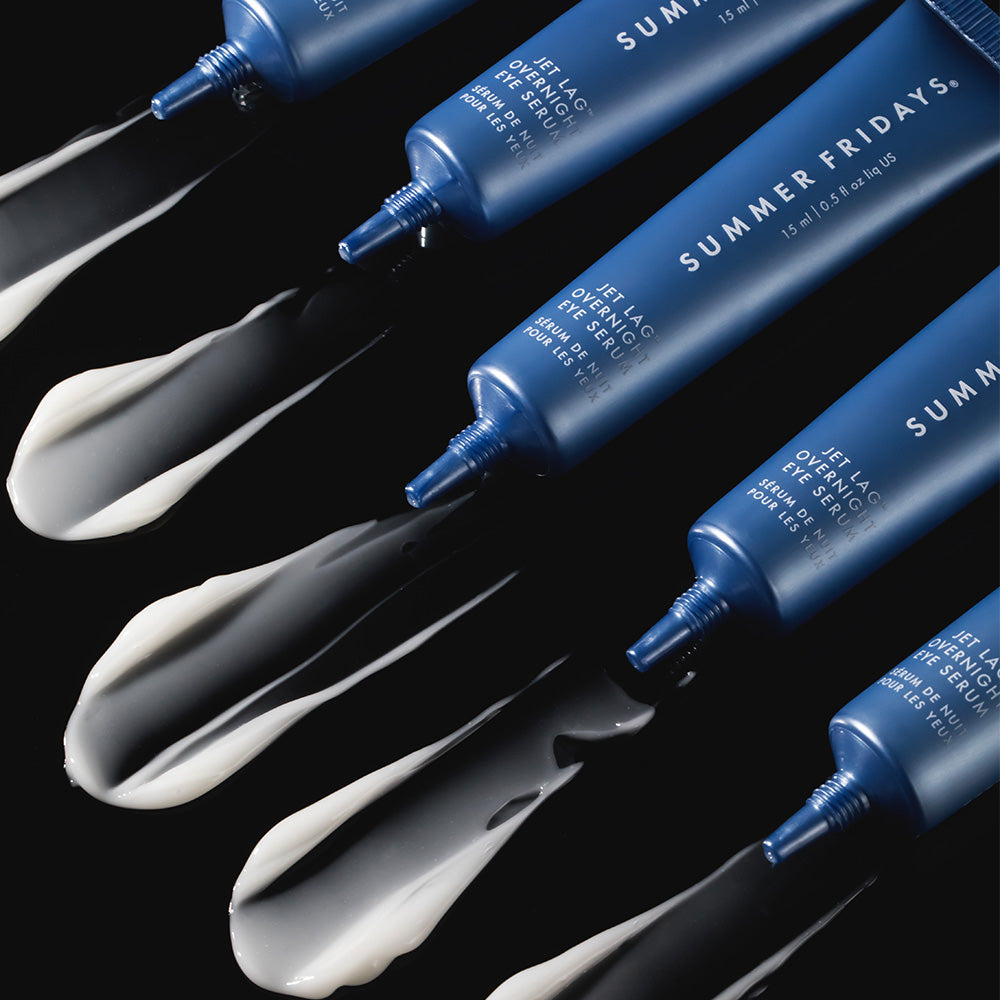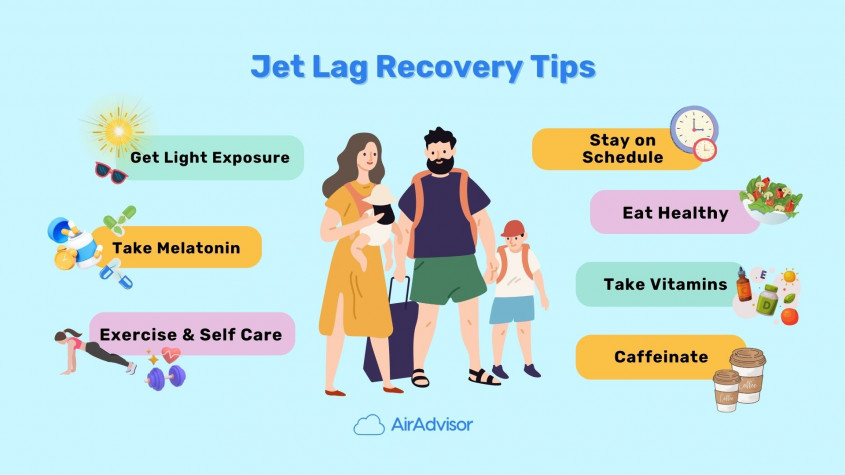Jet Lag Self-Care Strategies Stay hydrated, get plenty of sunlight, and rest when possible to combat jet lag. Adjust your sleep schedule before travel.
Jet lag can disrupt your body’s internal clock, leading to fatigue and disorientation. This common condition affects travelers crossing multiple time zones. Symptoms often include insomnia, irritability, and difficulty concentrating. To minimize jet lag, start by gradually shifting your sleep schedule before departure.
Stay hydrated throughout your journey, as dehydration can worsen symptoms. Exposure to natural light helps regulate your body’s circadian rhythm, so spend time outdoors during daylight hours. Short naps can also be beneficial but avoid sleeping too long during the day. By following these self-care tips, you can reduce the impact of jet lag and enjoy your trip more fully.

Credit: summerfridays.com
Introduction To Jet Lag
Jet lag occurs when your body’s internal clock is out of sync. This happens after traveling across multiple time zones. It affects your sleep, mood, and energy levels. Understanding jet lag is the first step to managing it effectively.
What Causes Jet Lag?
Jet lag is caused by disruptions to your circadian rhythm. This is your body’s natural sleep-wake cycle. Traveling across time zones confuses this internal clock. The more time zones crossed, the worse the jet lag.
| Cause | Description |
|---|---|
| Time Zone Changes | Your body can’t adjust quickly to new times. |
| Long Flights | Extended periods of inactivity affect your body. |
| Cabin Pressure | Changes in air pressure can impact your comfort. |
| Dehydration | Airplane air is dry, leading to dehydration. |
Symptoms To Recognize
Recognizing jet lag symptoms can help you take action. Common symptoms include:
- Fatigue and tiredness
- Difficulty sleeping
- Headaches and dizziness
- Mood changes like irritability
- Stomach issues like nausea
If you notice these symptoms, it’s likely you have jet lag. Identifying symptoms early helps in managing them better.

Credit: consciousbychloe.com
Pre-flight Preparation
Jet lag can be a real challenge for travelers. Proper pre-flight preparation can make a significant difference. Getting ready for your flight involves several steps. By taking care of your body before you fly, you can reduce jet lag symptoms.
Adjusting Your Sleep Schedule
Start adjusting your sleep schedule a few days before your flight. Gradually shift your bedtime closer to the destination’s time zone. This helps your body get used to the new time zone.
- Move bedtime 30 minutes earlier or later each night.
- Use blackout curtains to help you sleep.
- Limit screen time before bed to improve sleep quality.
Dietary Considerations
Your diet plays a crucial role in how you feel during and after your flight. Certain foods and drinks can either help or hinder your adjustment to a new time zone.
| Do | Don’t |
|---|---|
| Eat light meals before your flight. | Avoid heavy, fatty foods. |
| Stay hydrated by drinking water. | Avoid caffeine and alcohol. |
| Include fresh fruits and vegetables in your diet. | Avoid sugary snacks and drinks. |
Following these dietary tips can help your body adjust more easily. It’s important to feel your best before you fly.
Essentials To Pack
Jet lag can be tough, but packing smartly helps ease the discomfort. Packing the right essentials ensures you stay comfortable, hydrated, and nourished during your flight. Let’s break down the key items you need for a smoother journey.
Comfort Items For The Flight
Comfort is crucial for long flights. Pack these items to ensure a restful journey:
- Neck Pillow: Supports your neck and prevents stiffness.
- Eye Mask: Blocks light, helping you sleep better.
- Earplugs: Reduces noise, making it easier to rest.
- Compression Socks: Improves circulation and reduces swelling.
- Blanket: Keeps you warm and cozy during the flight.
Hydration And Snacks
Staying hydrated and well-nourished is essential for combating jet lag. Consider packing these items:
- Reusable Water Bottle: Stay hydrated by refilling it throughout the flight.
- Electrolyte Tablets: Helps maintain hydration levels.
- Healthy Snacks: Pack nuts, fruits, and granola bars to keep your energy up.
- Herbal Tea Bags: Calming teas like chamomile can help you relax.
- Protein Bars: Provides a quick and easy energy boost.
During The Flight
Jet Lag Self-Care Strategies can be a real challenge. Taking care of yourself during the flight is essential. Simple steps can make your journey smoother. Here are some tips to help you feel better when you land.
Staying Hydrated
Staying hydrated is crucial during your flight. Airplane cabins have low humidity. This can cause dehydration. Drink water frequently. Avoid alcohol and caffeine. They can make dehydration worse.
Bring a reusable water bottle. Fill it up after passing security. Aim to drink at least one glass of water every hour. This keeps your body hydrated and feeling good.
Stretching And Moving
Stretching and moving during the flight is important. Sitting for long periods can cause stiffness. Stand up and walk around every hour. This improves blood circulation.
Here are some simple stretches you can do:
- Neck rolls: Gently roll your head in circles.
- Shoulder shrugs: Lift and lower your shoulders.
- Ankle circles: Rotate your ankles in circles.
These stretches can help you feel more comfortable. They also reduce the risk of blood clots.
Mastering Your Sleep On The Go
Traveling across time zones can disturb your sleep schedule. Jet lag often makes you feel tired and out of sync. Here are some tips to master your sleep while traveling.
Using Sleep Aids Wisely
Sleep aids can help you adjust to new time zones. But use them carefully. Over-the-counter options like melatonin can be effective. Take a small dose before bedtime. Avoid regular use to prevent dependency.
Prescription sleep aids can also help but consult a doctor first. They might have side effects. Always follow the prescribed dosage.
| Type | Usage | Precautions |
|---|---|---|
| Melatonin | Take 1-2 hours before sleep | Short-term use only |
| Prescription Sleep Aids | Follow doctor’s advice | Check for side effects |
Creating A Restful Environment
Making your sleeping area comfortable is key to good sleep. Use an eye mask to block out light. Earplugs can help reduce noise. Bring a travel pillow for neck support.
Adjust the room temperature to your liking. A cooler room often promotes better sleep. Use a white noise app to drown out background sounds.
- Eye mask
- Earplugs
- Travel pillow
- White noise app
Keep your sleeping area clean and clutter-free. This helps create a peaceful environment. Make sure your bed is comfortable. A good mattress and pillow can make a big difference.
Post-flight Recovery
After a long flight, your body needs time to adjust. Post-flight recovery is essential to get back on track. Simple self-care steps can help you feel better quickly.
Natural Light Exposure
Natural light helps reset your internal clock. Spend time outside during daylight hours. Aim for at least 15-30 minutes of sunlight.
Here are some tips to make the most of natural light:
- Take a walk in a nearby park.
- Sit by a sunny window with a book.
- Eat your meals outside if possible.
Natural light exposure can significantly reduce jet lag symptoms. It helps your body know it’s daytime.
Gentle Exercise
Gentle exercise can boost your mood and energy levels. Focus on low-impact activities like walking or stretching.
Consider these gentle exercises:
- Take a leisurely stroll around your hotel or neighborhood.
- Do some simple yoga poses to stretch your muscles.
- Engage in light stretching exercises in your room.
These activities can help improve blood flow and reduce stiffness. Gentle exercise aids in quicker recovery from jet lag.
Dietary Tips For Recovery
Jet lag can disrupt your body’s natural rhythms. The right foods can help. Eating correctly aids faster recovery. Follow these dietary tips to bounce back quicker.
Foods To Favor
Certain foods can help you adjust to new time zones. These foods support sleep and energy levels.
- Bananas: Rich in magnesium and potassium. They help relax muscles and promote sleep.
- Oats: High in fiber, they keep you full and help regulate sleep.
- Cherries: Natural source of melatonin. They support better sleep patterns.
- Salmon: Packed with omega-3 fatty acids. They reduce inflammation and improve brain function.
- Dark leafy greens: Full of vitamins and minerals. They boost energy and support overall health.
Foods To Avoid
Some foods can worsen jet lag symptoms. Avoid these to recover quicker.
- Caffeine: It can disrupt your sleep schedule. Avoid coffee, tea, and soda.
- Alcohol: It affects sleep quality. It can make you feel more tired.
- Sugary foods: They cause energy spikes and crashes. Avoid candies, pastries, and sugary drinks.
- Fried foods: They are hard to digest. They can make you feel sluggish.
- Spicy foods: They can cause digestive issues. This can interfere with sleep.
| Foods to Favor | Foods to Avoid |
|---|---|
| Bananas | Caffeine |
| Oats | Alcohol |
| Cherries | Sugary foods |
| Salmon | Fried foods |
| Dark leafy greens | Spicy foods |
Jet Lag Self-Care Long-term Strategies
Jet lag can disrupt your daily routine and well-being Self-Care Strategies. Implementing long-term strategies is essential. These techniques help your body adapt. They ensure smoother travel experiences and better health.
Building A Flexible Routine
Establishing a flexible routine is crucial. This helps your body adjust. Follow these steps:
- Consistent Sleep Schedule: Go to bed and wake up at the same time daily.
- Balanced Diet: Eat nutritious meals at regular intervals.
- Regular Exercise: Engage in physical activity to boost energy levels.
A flexible routine prepares your body for time zone changes. It reduces the impact of jet lag.
Mindfulness And Relaxation Techniques
Jet Lag Self-Care Strategies, Mindfulness and relaxation techniques are effective. They help manage stress and improve sleep quality. Consider these practices:
| Technique | Benefits |
|---|---|
| Meditation | Calms the mind and reduces anxiety. |
| Deep Breathing | Promotes relaxation and better sleep. |
| Yoga | Enhances flexibility and mental clarity. |
Incorporating these techniques into your daily routine can make a significant difference. They help your body and mind adapt to new time zones.

Credit: www.livehealthily.com
Frequently Asked Questions
How To Recover From Jet Lag Quickly?
To recover from jet lag quickly, adjust to the new time zone immediately. Stay hydrated, get sunlight, and avoid caffeine. Rest well before the flight and take short naps if needed.
How Long Does It Take For Jet Lag To Wear Off?
Jet lag usually wears off within a few days to a week. Recovery time depends on the number of time zones crossed.
What Are 5 Symptoms Of Jet Lag?
Five symptoms of jet lag include fatigue, insomnia, difficulty concentrating, mood swings, and stomach issues.
What To Avoid During Jet Lag?
Avoid caffeine and alcohol. Stay away from heavy meals before bedtime. Don’t nap for long periods. Avoid screen time before sleep. Limit physical activity close to bedtime.
Conclusion
Taking care of yourself during jet lag is essential. Follow these tips to adjust quickly and comfortably. Prioritize rest, stay hydrated, and maintain a balanced diet. Gradually adapt to the new time zone and seek natural light exposure. With these strategies, you can minimize jet lag and enjoy your travels more.




Leave a Reply